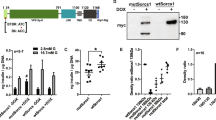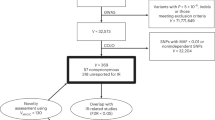Abstract
Type II diabetes is caused by a failure of the pancreatic β-cells to compensate for insulin resistance leading to hyperglycaemia. There is evidence for an essential role of an increased β-cell apoptosis in type II diabetes. High glucose concentrations induce IL-1β production in human β-cells, Fas expression and concomitant apoptosis owing to a constitutive expression of FasL. FASL and FAS map to loci linked to type II diabetes and estimates of insulin resistance, respectively. We have tested two functional promoter polymorphisms, FAS-670 G>A and FASL-844C>T as well as a microsatellite in the 3′ UTR of FASL for association to type II diabetes in 549 type II diabetic patients and 525 normal-glucose-tolerant (NGT) control subjects. Furthermore, we have tested these polymorphisms for association to estimates of β-cell function and insulin resistance in NGT subjects. We found significant association to type II diabetes for the allele distribution of the FASL microsatellite (P-value 0.02, Bonferroni corrected). The FAS-670G>A was associated with homeostasis model assessment insulin resistance index and body mass index (P-values 0.02 and 0.02). We conclude that polymorphisms of FASL and FAS associate with type II diabetes and estimates of insulin resistance in Danish white subjects.
This is a preview of subscription content, access via your institution
Access options
Subscribe to this journal
Receive 6 digital issues and online access to articles
$119.00 per year
only $19.83 per issue
Buy this article
- Purchase on Springer Link
- Instant access to full article PDF
Prices may be subject to local taxes which are calculated during checkout

Similar content being viewed by others
Abbreviations
- AP-1:
-
activation protein-1
- ASK-1:
-
apoptosis signal-regulating kinase 1
- BMI:
-
body mass index
- DISC:
-
death-inducing signalling complex
- EBPβ:
-
enhancer-binding protein beta element
- FLIP:
-
FLICE (caspase-8) inhibitory protein
- HOMA:
-
homeostasis model assessment
- IR1:
-
fasting-insulin/fasting-glucose ratio
- IRS-1:
-
insulin receptor substrate 1
- JNK:
-
c-Jun N-terminal kinase
- MAPK:
-
mitogen-activated protein kinase
- NGT:
-
normal-glucose-tolerant
- OGTT:
-
oral glucose tolerance test
- STAT:
-
signal transducer and activator of transcription
References
Kloppel G, Lohr M, Habich K, Oberholzer M, Heitz PU . Islet pathology and the pathogenesis of type 1 and type 2 diabetes mellitus revisited. Surv Syn Pathol Res 1985; 4 (2): 110–125.
Rich SS . Mapping genes in diabetes. Genetic epidemiological perspective. Diabetes 1990; 39 (11): 1315–1319.
Ghosh S, Hauser ER, Magnuson VL, Valle T, Ally DS, Karanjawala ZE et al. A large sample of Finnish diabetic sib-pairs reveals no evidence for a non-insulin-dependent diabetes mellitus susceptibility locus at 2qter. J Clin Invest 1998; 102 (4): 704–709.
Poulsen P, Ohm Kyvik K, Vaag A, Beck-Nielsen H . Heritability of type II (non-insulin-dependent) diabetes mellitus and abnormal glucose tolerance – a population-based twin study. Diabetologia 1999; 42 (2): 139–145.
Andersen G, Hansen T, Pedersen O . Genetics of common forms of glycaemia with pathological impact on vascular biology: are we on the right tract? Curr Mol Med 2005; 5 (3): 261–274.
Butler AE, Janson J, Bonner-Weir S, Ritzel R, Rizza RA, Butler PC . Beta-cell deficit and increased beta-cell apoptosis in humans with type 2 diabetes. Diabetes 2003; 52 (1): 102–110.
Sakuraba H, Mizukami H, Yagihashi N, Wada R, Hanyu C, Yagihashi S . Reduced beta-cell mass and expression of oxidative stress-related DNA damage in the islet of Japanese type II diabetic patients. Diabetologia 2002; 45 (1): 85–96.
Spranger J, Kroke A, Möhlig M, Hoffmann K, Bergmann MM, Ristow M et al. Inflammatory cytokines and the risk to develop type 2 diabetes: results of the prospective population-based European Prospective Investigation into Cancer and Nutrition (EPIC)-Potsdam Study. Diabetes 2003; 52 (3): 812–817.
Maedler K, Spinas GA, Lehmann R, Sergeev P, Weber M, Fontana A et al. Glucose induces beta-cell apoptosis via upregulation of the Fas receptor in human islets. Diabetes 2001; 50 (8): 1683–1690.
Loweth AC, Williams GT, James RFL, Scarpello JHB, Morgan NG . Human islets of Langerhans express fas ligand and undergo apoptosis in response to interleukin-1β and fas ligation. Diabetes 1998; 47 (5): 727–732.
Wiltshire S, Hattersley AT, Hitman GA, Walker M, Levy JC, Sampson M et al. A genomewide scan for loci predisposing to type 2 diabetes in a UK population (The diabetes UK Warren 2 repository): analysis of 573 pedigrees provides independent replication of a susceptibility locus on chromosome 1q. Am J Hum Genet 2001; 69 (3): 553–569.
Ghosh S, Watanabe RM, Valle TT, Hauser ER, Magnuson VL, Langefeld CD et al. The Finland-United States Investigation of Non-Insulin-Dependent Diabetes Mellitus Genetics (FUSION) study. I. An autosomal genome scan for genes that predispose to type 2 diabetes. Am J Hum Genet 2000; 67 (5): 1174–1185.
Budihardjo I, Oliver H, Lutter M, Luo X, Wang X . Biochemical pathways of caspase activation during apoptosis. Annu Rev Cell Dev Biol 1999; 15: 269–290.
Cohen GM . Caspases: the executioners of apoptosis. Biochem J 1997; 326 (Part 1): 1–16.
Maedler K, Fontana A, Ris F, Sergeev P, Toso C, Oberholzer J et al. FLIP switches Fas-mediated glucose signaling in human pancreatic beta cells from apoptosis to cell replication. Proc Natl Acad Sci USA 2002; 99 (12): 8236–8241.
Nolsoe RL, Kristiansen OP, Sangthongpitag K, Larsen ZM, Johannesen J, Karlsen AE et al. Complete molecular scanning of the human Fas gene: mutational analysis and linkage studies in families with type I diabetes mellitus. Diabetologia 2000; 43 (6): 800–808.
Nolsoe RL, Kristiansen OP, Larsen ZM, Johannesen J, Pociot F, Mandrup-Poulsen T . Complete mutation scan of the human Fas ligand gene: linkage studies in type I diabetes mellitus families. Diabetologia 2002; 45 (1): 134–139.
Nolsoe RL, Kelly JA, Pociot F, Moser KL, Kristiansen OP, Mandrup-Poulsen T et al. Functional promoter haplotypes of the human FAS gene are associated with the phenotype of SLE characterized by thrombocytopenia. Genes Immun 2005; 6 (8): 699–706.
Maedler K, Sergeev P, Ris F, Oberholzer J, Joller-Jemelka HI, Spinas GA et al. Glucose-induced beta cell production of IL-1beta contributes to glucotoxicity in human pancreatic islets. J Clin Invest 2002; 110 (6): 851–860.
Sun T, Zhou Y, Li H, Han X, Shi Y, Wang L et al. FASL-844C polymorphism is associated with increased activation-induced T cell death and risk of cervical cancer. J Exp Med 2005; 202 (7): 967–974.
Wu J, Metz C, Xu X, Abe R, Gibson AW, Edberg JC et al. A novel polymorphic CAAT/enhancer-binding protein beta element in the FasL gene promoter alters Fas ligand expression: a candidate background gene in African American systemic lupus erythematosus patients. J Immunol 2003; 170 (1): 132–138.
Welsh N, Cnop M, Kharroubi I, Bugliani M, Lupi R, Marchetti P et al. Is there a role for locally produced interleukin-1 in the deleterious effects of high glucose or the type 2 diabetes milieu to human pancreatic islets? Diabetes 2005; 54 (11): 3238–3244.
Wajant H, Pfizenmaier K, Scheurich P . Non-apoptotic Fas signaling. Cytokine Growth Factor Rev 2003; 14 (1): 53–66.
Kaneto H . The JNK pathways as a therapeutic target for diabetes. Expert Opin Ther Targets 2005; 9 (3): 581–592.
Hirosumi J, Tuncman G, Chang L, Gorgun CZ, Uysal KT, Maeda K et al. A central role for JNK in obesity and insulin resistance. Nature 2002; 420 (6913): 333–336.
Lee YH, Giraud J, Davis RJ, White MF . c-Jun N-terminal kinase (JNK) mediates feedback inhibition of the insulin signaling cascade. J Biol Chem 2003; 278 (5): 2896–2902.
Kaneto H, Nakatani Y, Miyatsuka T, Kawamori D, Matsuoka TA, Matsuhisa M et al. Possible novel therapy for diabetes with cell-permeable JNK-inhibitory peptide. Nat Med 2004; 10 (10): 1128–1132.
Hanson RL, Ehm MG, Pettitt DJ, Prochazka M, Thompson DB, Timberlake D et al. An autosomal genomic scan for loci linked to type II diabetes mellitus and body-mass index in Pima Indians. Am J Hum Genet 1998; 63 (4): 1130–1138.
Elbein SC, Hoffman MD, Teng K, Leppert MF, Hasstedt SJ . A genome-wide search for type 2 diabetes susceptibility genes in Utah Caucasians. Diabetes 1999; 48 (5): 1175–1182.
Vionnet N, Hani EH, Dupont S, Gallina S, Francke S, Dotte S et al. Genomewide search for type 2 diabetes-susceptibility genes in French whites: evidence for a novel susceptibility locus for early-onset diabetes on chromosome 3q27-qter and independent replication of a type 2-diabetes locus on chromosome 1q21–q24. Am J Hum Genet 2000; 67 (6): 1470–1480.
Drivsholm T, Ibsen H, Schroll M, Davidsen M, Borch-Johnsen K . Increasing prevalence of diabetes mellitus and impaired glucose tolerance among 60-year-old Danes. Diabetic Med 2001; 18 (2): 126–132.
WHO Study Group. Report of a WHO Consultation. Part 1: Diagnosis and Classification of Diabetes Mellitus. World Health Organization: Geneva, 1999 Ref Type: Pamphlet.
Matthews DR, Hosker JP, Rudenski AS, Naylor BA, Treacher DF, Turner RC . Homeostasis model assessment: insulin resistance and beta-cell function from fasting plasma glucose and insulin concentrations in man. Diabetologia 1985; 28 (7): 412–419.
Kosaka K, Hagura R, Kuzuya T, Kuzuya N . Insulin secretory response of diabetics during the period of improvement of glucose tolerance to normal range. Diabetologia 1974; 10 (6): 775–782.
Acknowledgements
We thank Marja Deckert, Anette Hellgren, Annemette Forman, Lene Aabo, Marianne Stendal and Inge Lise Wantzin for dedicated and careful technical assistance and Karen Rahbek Kruse and Grete Lademann for secretarial support. The study was supported by grants from the Danish Medical Research Council, the Danish Diabetes Association and the European Union (EUGENE2, LSHM-CT-2004-512013).
Author information
Authors and Affiliations
Corresponding author
Rights and permissions
About this article
Cite this article
Nolsøe, R., Hamid, Y., Pociot, F. et al. Association of a microsatellite in FASL to type II diabetes and of the FAS-670G>A genotype to insulin resistance. Genes Immun 7, 316–321 (2006). https://doi.org/10.1038/sj.gene.6364300
Received:
Revised:
Accepted:
Published:
Issue Date:
DOI: https://doi.org/10.1038/sj.gene.6364300
Keywords
This article is cited by
-
Polymorphisms in the FAS gene are associated with susceptibility to noise-induced hearing loss
Environmental Science and Pollution Research (2021)
-
Single nucleotide polymorphisms within functional regions of genes implicated in insulin action and association with the insulin resistant phenotype
Molecular and Cellular Biochemistry (2011)



